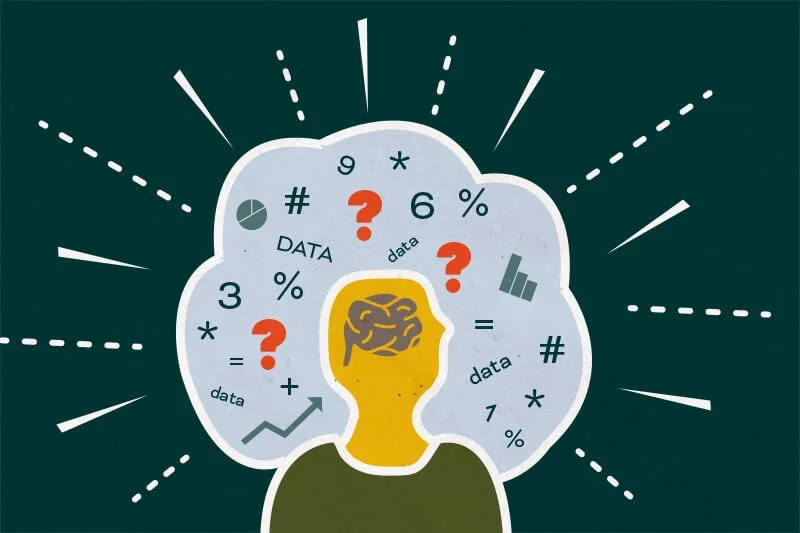How to use Data to Map Out Your Nonprofit’s Success
An interview with data pro Duncan McGovern
I admit, understanding data is not in my wheelhouse as a creative professional. To me, it’s a nebulous blanket term for “lots of information about stuff and people that marketing folks use” but I struggle to wrap my head around what it truly means and why it’s important. When I met Duncan at a recent consultants' meetup, I knew he could help me get to the bottom of my burning question: What the heck is data? Duncan works with conservation and outdoor-recreation focused nonprofits to increase their engagement using…you guessed it: DATA! Whether you’re totally clueless about data (like me) or have been dabbling for some time, this Q&A with Duncan will inspire you to think about how to use the data you have to elevate the different ways people support your mission, their journey, and how they engage with your organization.
Margo: Let's just get this question out of the way: What the heck is data?
Duncan: Data are building blocks—individual facts and figures that we can organize to get information. Sometimes basic organization is all that we need, like keeping track of new donors who need a thank-you call. Your data may include who made a gift, whether it was the first time they donated, if they have received a call or not. The information in this case could form a to-do list: new donors who haven’t yet received a call.
Aggregates are another way you can use data to generate information, like adding up all the gifts within a specific campaign. This lets you compare how one campaign performed vs another, and whether you’re on pace for overall fundraising goals this year.
The last layer is insight—new understanding that can guide your decisions in the future. This is where you start to get answers to the “why” questions: why did this campaign perform better than the last one? What could we do differently next time? To get here you need a good information layer, supported by solid data.
Margo: How do you explain CRM data to a non-marketer? Why is it important? How can it be used?
Duncan: Let’s start with “CRM”. It’s an acronym for “Customer Relationship Management” or as we might think about in the nonprofit sector, “Constituent Relationship Management.” The thing about relationships is that they develop over time and are 1:1. So a CRM helps you keep track of data that hopefully provides information and context about how a particular person has interacted with and relates to your organization, like whether someone has volunteered, donated, or participated in a program. A simple example of why this information can be helpful is differentiating between someone who has donated recently and someone who has never donated when deciding what message someone receives in your next appeal.
Margo: What platforms (Salesforce, HubSpot, etc) do you use? Do you have a favorite one that you recommend to your clients?
Duncan: We mostly use Salesforce and it’s a really great tool in a lot of ways. That said, it can be overkill and difficult to manage for smaller organizations. There are definitely small nonprofits that can thrive on Salesforce, but there’s real risk of doing too much to fast. The term ‘technology debt’ is a good one—you can pretty easily end up building something with short term benefits and more long term cost than you realize if not managed well.
We’re getting into Hubspot a bit more, in part due to our focus on marketing and engagement (it’s got a great suite of marketing features), and also as a platform that’s powerful but a notch easier to manage than Salesforce. And there are a ton of things you simply get out of the box—like one platform that can be your CRM and email tool (and website!) all in one. Historically it hasn’t been a tool that’s really on the radar of a lot of nonprofits, even though they do have a significant discount. I think that might start to change.
Margo: How do you explain engagement to a non-marketer? Why is it important?
Duncan: Engagement is the overall picture of someone’s interactions with your organization. From low-level engagement like following on social media or reading an email newsletter, to higher levels like one-off donations or volunteering, to recurring donors, joining the board… we know these actions all demonstrate different levels of commitment to the organization. But sometimes it’s easy for each department to focus just on one type of interaction. The Development department wants to increase gift size and frequency. The Programs department wants more participants. The Advocacy department wants names on petitions and people speaking up in town halls. Engagement captures all of those things rather than focusing on the track within a single department.
Margo: How do you tap into the user journey? How does understanding this journey drive decisions within an organization?
Duncan: It’s important to remember that for most organizations (at least the ones we work with), there’s not one journey. That’s part of the beauty of nonprofits—for many orgs, there are different ways in which people support your mission–volunteering, attending events, donations, advocacy, etc. So identifying different types of interactions and focusing on a consistent and personalized experience rather than a single ‘journey’ is how we like to think about it.
This means that the context and history of two people interacting with your organization in the same way might be very different. And understanding that can help not only inform marketing (right message) but even program design.
Margo: When you see an org with low engagement, where do you typically start?
Duncan: Ask staff what they think is going on! There’s always institutional knowledge and that’s the first place we look for a hypothesis about what’s going on. I think there’s a misconception that your tech systems are a treasure trove of undiscovered information, and the right report will just unearth a set of instructions for what to do. This might become more viable with AI in the future, but the success stories we’ve seen (AI included) all start with a pretty narrow focus on a limited number of factors to support or disprove a hypothesis.
Once we have a hypothesis, we’ll generally look at the existing data to see how well it aligns. Sometimes we have guesses of our own to explore or specific items we see that are problematic, but we’re trying to use data to back that up or challenge the assumptions, not start from scratch.
Then we can start to build a plan for what to change and how we’ll measure improvements to know if they were successful or not. Creating marketing content or messaging isn’t our forté, so if an org is really struggling we might recommend they talk with someone who can help set a strategic direction and/or create that content. Then we help use data to identify the right recipients for a new initiative or message and measure the results.
Margo: Let’s say an organization has collected a bunch of data from its supporters and constituents, what’s next?
Duncan: It’s common to see an organization collecting data without a clear plan for how it’s going to be used, you wind up putting time and resources into your tech and never see any return. That said, here are some suggestions.
Be specific in how you will use the data you want to collect. Make sure there’s not only a clear plan but also capacity to execute before putting in the effort up front.
Stay centered on your organization’s mission, start high-level and work down from there. If your organization has four key programs or areas of focus, can you easily determine which of those areas a given contact in your CRM has engaged with? This sounds really simple but it’s pretty common to see multiple ways of tracking “interests” across systems that don’t line up with each other or the mission of the organization.
Now, data isn’t so scary after all, is it? I hope this gives you some confidence to take a look at your organization’s data in a way that helps make informed decisions about how, when and where you talk to your audience. If you need a nudge to get started looking at your data, Duncan and I worked together to create this handy Engagement Pyramid worksheet to help you better understand your audience engagement.
Duncan is the founder of Pedal Lucid, a small consulting firm that specializes in helping conservation and outdoor-recreation focused nonprofits use data to increase engagement. He’s passionate about technology and even more passionate about helping people use it effectively. He lives in Missoula, MT and loves year-round outdoor recreation (skiing, biking, running…) with his wife and two young sons.
Margo is a graphic designer who works with environmental nonprofits and mission-driven brands on projects like logos & branding, annual reports, maps, and infographics. She works with clients to create beautiful and meaningful design that amplifies the marketing efforts it takes to ignite action and change. Visit her portfolio to see her work.




